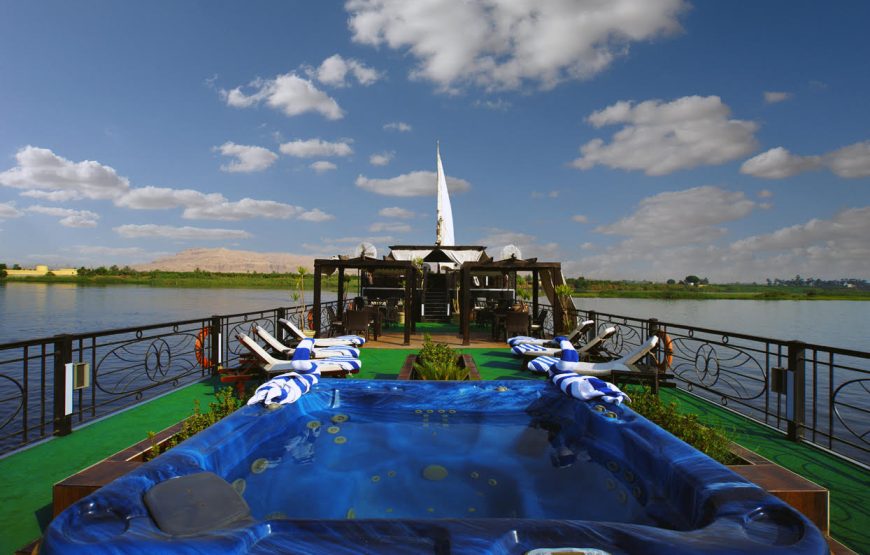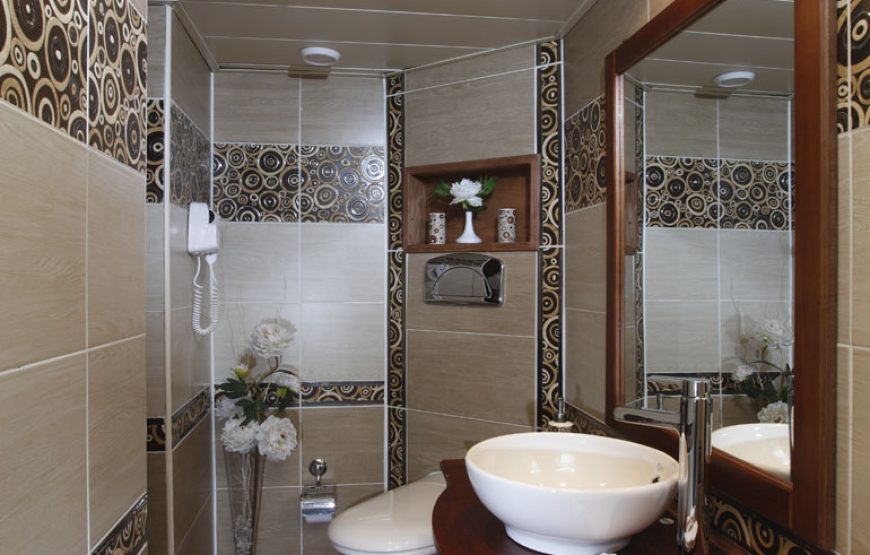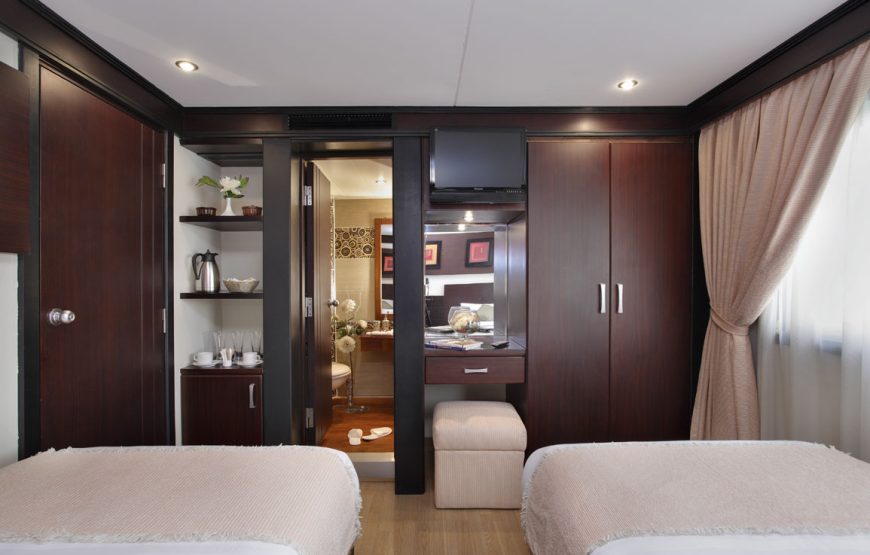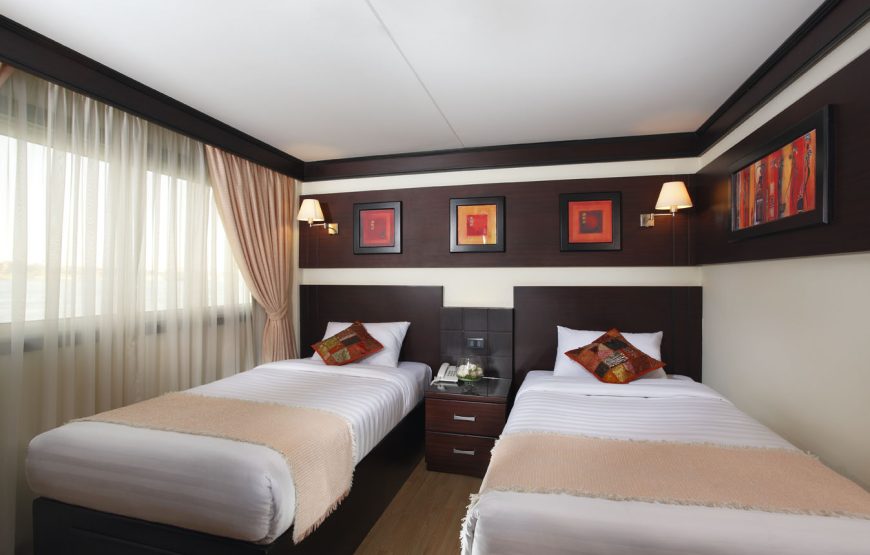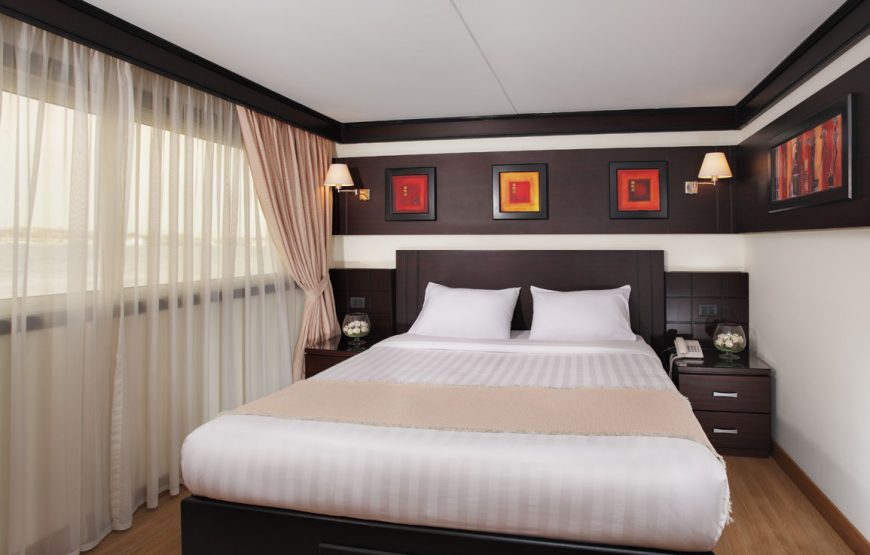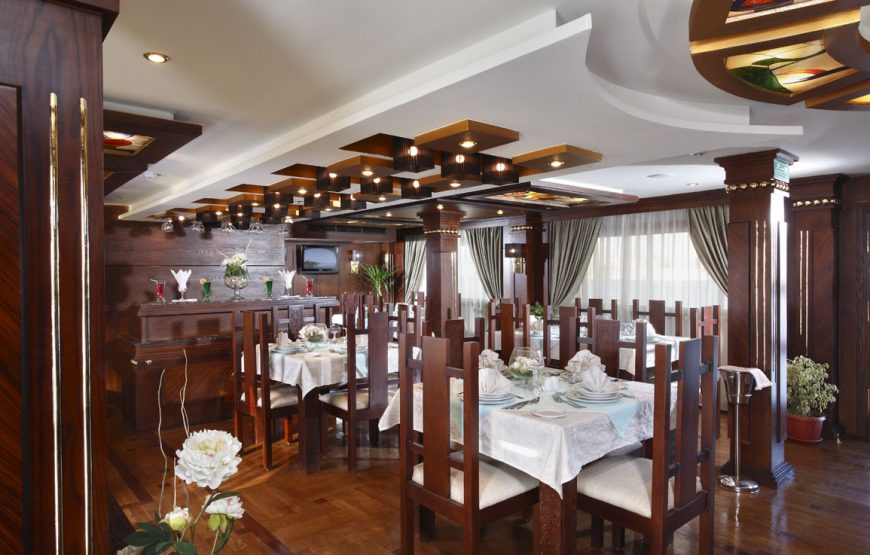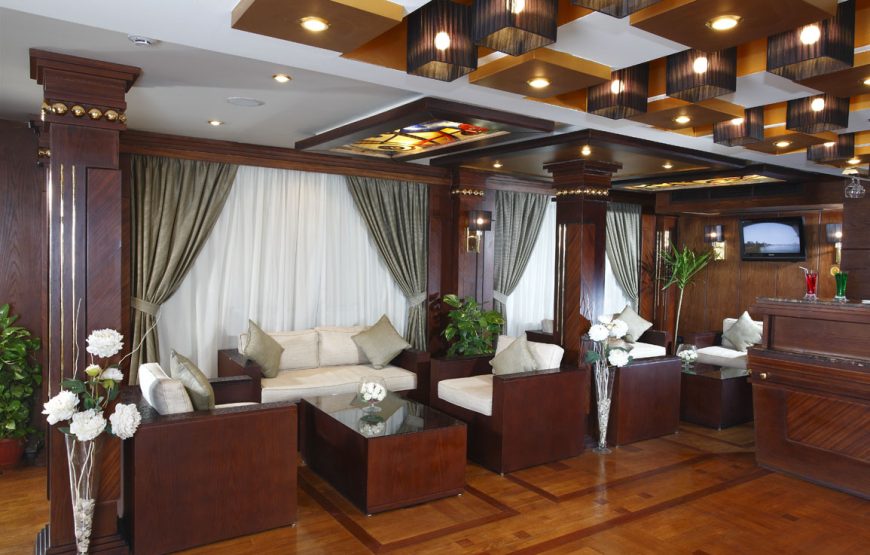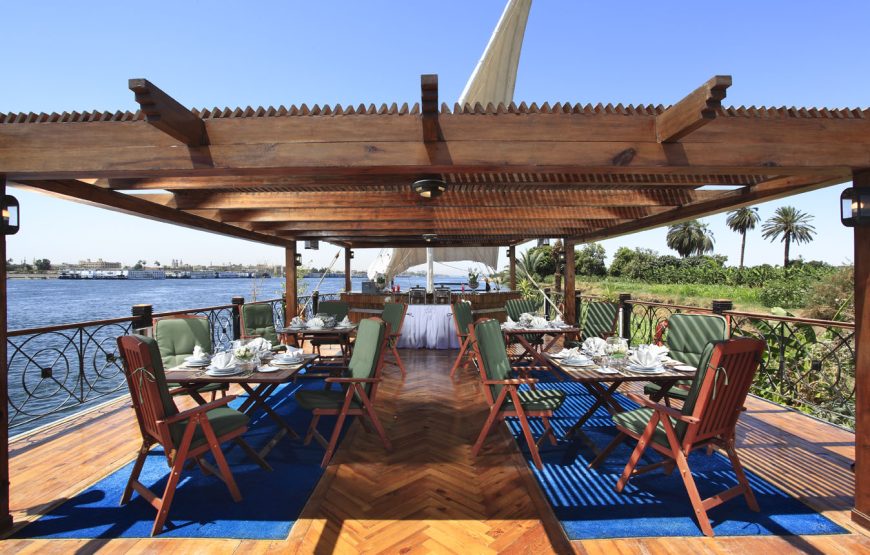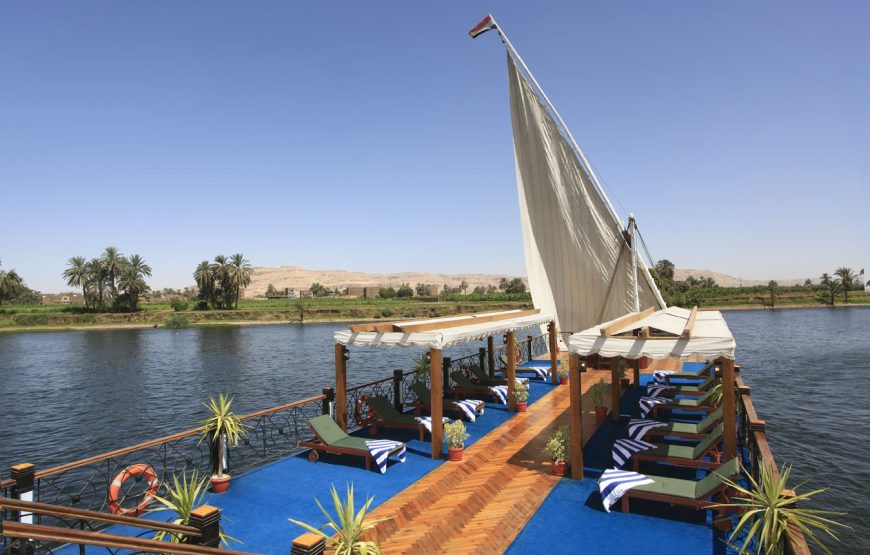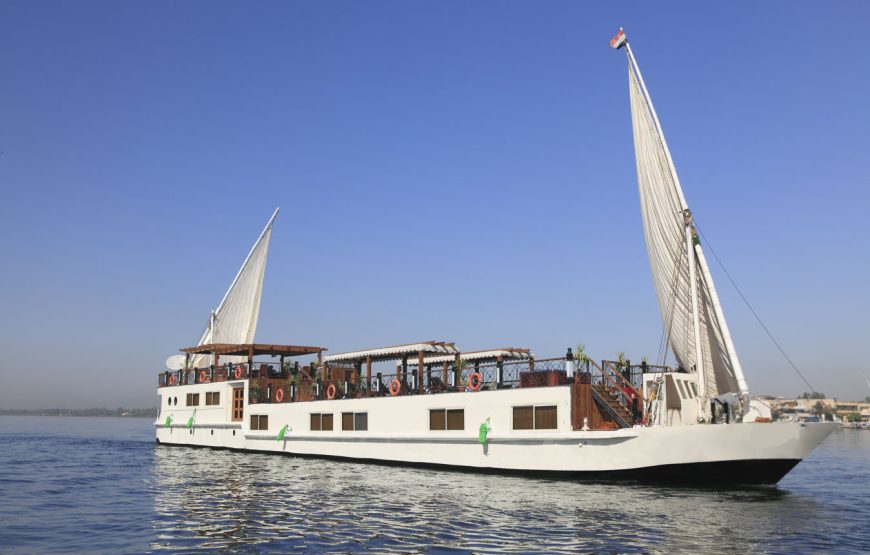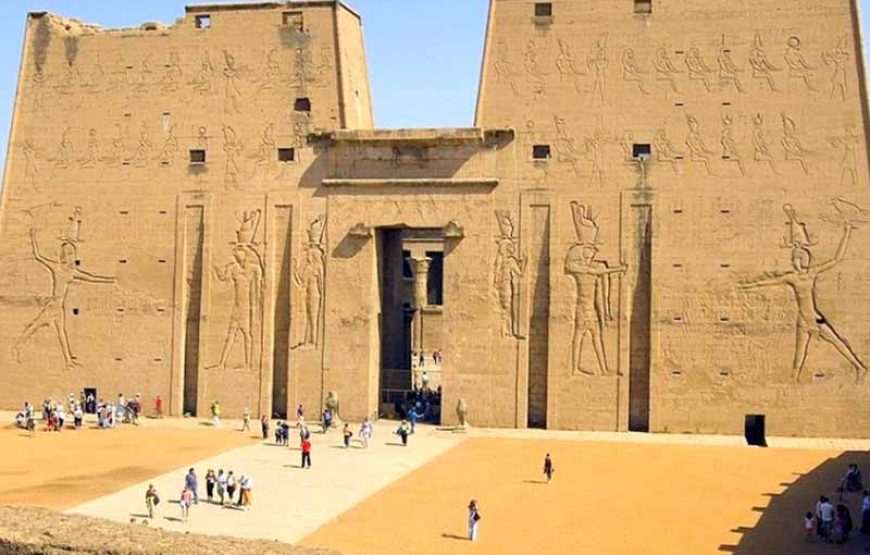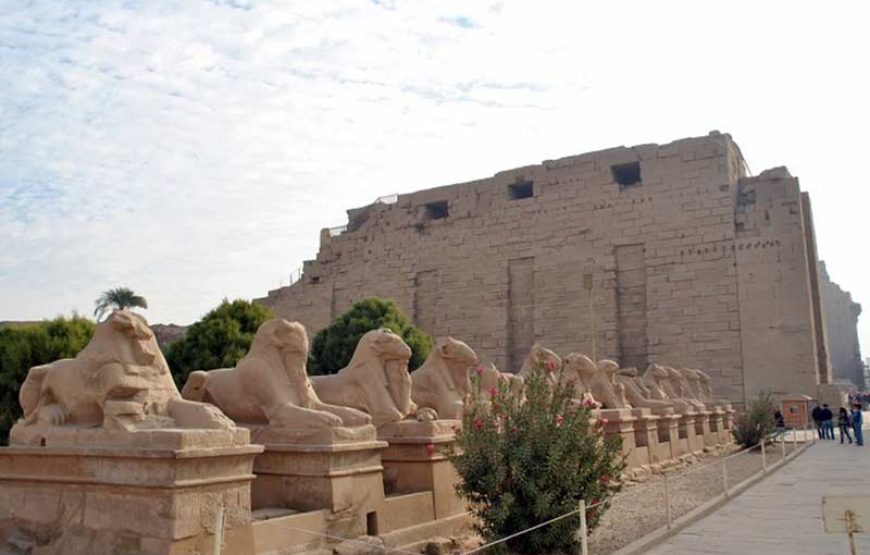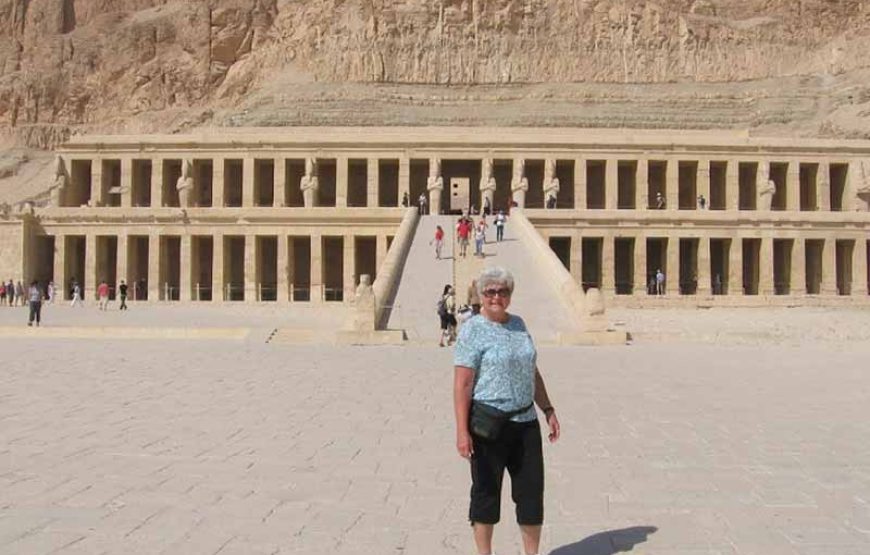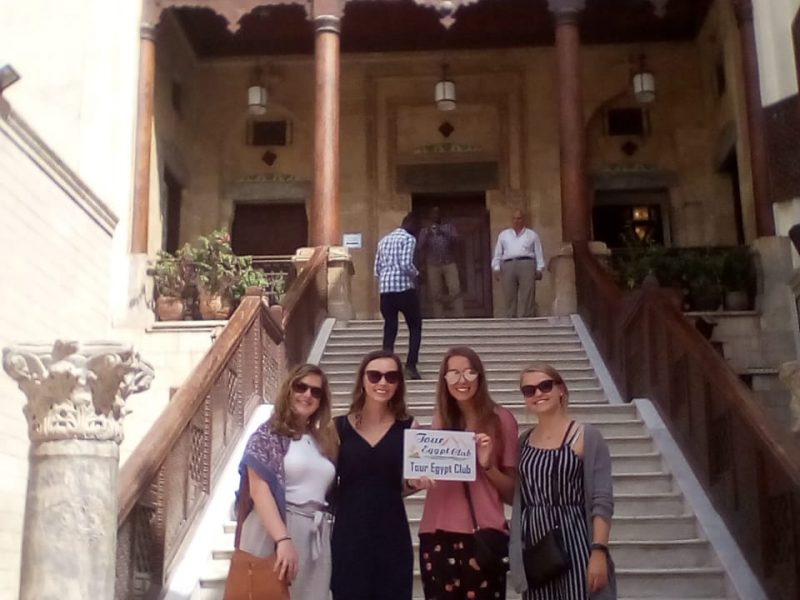Itinerary 4 Days 3 Nights Every Wednesday From Aswan to Luxor:
Every Wednesday From Aswan to Esna
Day 01 |Temple of Philae |High Dam| the Nubian Village (Optional Visit)
Upon arrival at Aswan pick you up from any place from your choice in Aswan (Airport – Station – Hotel) then met by your personal guide who will accompany you by car with air conditioning to start our visit at 8:30 AM:
Witness Temple of Philae
Built to honor the goddess Isis, this was the last temple built in the classical Egyptian style. Construction began around 690 BC, and it was one of the last outposts where the goddess was worshipped. The cult of Isis continued here until at least AD 550. The boat leaves you near the Kiosk of Nectanebo, the oldest part, and the entrance to the temple is marked by the 18m-high first pylon with reliefs of Ptolemy XII NeosDionysos smiting enemies.
Next step continue to visit: Aswan High Dam
Egypt's modern example of construction on a monumental scale, the controversial Aswan High Dam, 13km south of Aswan, contains 18 times the amount of material used in the Great Pyramid of Khufu and created Lake Nasser, one of the world's largest artificial lakes.
The Nubian Village in the evening (Optional Visit)
Nubian villages are located among lush palm groves and their houses are painted in blue, pink or yellow.
This village is located west of Suhail, but its inhabitants have been able to take advantage of the beautiful landscapes that surround them, as it has become one of the most popular villages where tourists from all over the world come.
, this amazing Nubian village tour allows you to meet and impact with a Nubian family and to learn about their simple lifestyle, culture and traditions.
-After this trip you will be transferred to Dahabyia and stay overnight.
-Check in Dahabyia.
-Overnight on board Dahabyia
Meals :Lunch,Dinner
Day02| Abu Simbel (Optional)| Temple of Kom Ombo| Sailing to Esna
After enjoying the breakfast check out from Dahabyia and then met by your personal guide who will accompany you by car with air conditioning to visit:
Abu Simbel (Optional)
The two Temples of Abu Simbel, with their unique style, are considered to be the masterpieces of ancient Egypt. They reflect the glory and grandeur of the new Kingdom. The Egyptian government and UNESCO decided to co-operate in order to save these temples from the flood. The Temple of Ramsses II was dedicated to the four universal gods Ptah, Re-Her-Akhtey, Amun-Re, and to Ramsses II himself. The great Abu Simbel temple is also called The Sun Temple of RamssessII.The Temple of Queen Nefertari is also Called Temple of Hathor who was the wife of the Sun God so in a symbolic way, the two Temples, that of Ramsses II and that of Nefertari, bring Ramesses II, Nefertari, Hathor and the Sun God together as one.
Next step continue to visit Temple of Kom Ombo
Standing on a promontory at a bend in the Nile, where in ancient times sacred crocodiles basked in the sun on the riverbank, is the Temple of Kom Ombo, one of the Nile Valley's most beautifully sited temples. Unique in Egypt, it is dedicated to two gods; the local crocodile god Sobek, and Haroeris (from har-wer), meaning Horus the Elder
-After this trip you will be transferred to Dahabyia and then continue sailing to Esna
-Overnight on board Dahabyia
Meals: Breakfast, Lunch, Dinner
Day03| Esna Temple | Sailing to Luxor | Visit East Bank, Luxor temple | Karnak Temple
After enjoying the breakfast check out from Dahabyia and then met by your personal guide who will accompany you by car with air conditioning to visit:
Esna Temple
The Temple of Khnum is indeed an interesting site because it sits roughly nine meters below the street level, and records suggest that it was constructed on top of an earlier temple. Historians generally believe the origin of the site to be connected to Tuthmosis III.
Given what has been mentioned above, the Temple of Khnum is considered to be one of the last temples to have been built by the true Ancient Egyptians. This makes it quite valuable because it is one of the few ancient temples in which the roof is still intact, and in which various eras of construction can still be found. There are four rows of massive columns in the main hall and some even retain their ancient painted colors to this day.
Then witness Luxor Temple:
Largely built by the New Kingdom pharaohs Amenhotep III (1390–1352 BC) and Ramses II (1279–1213 BC), this temple is a strikingly graceful monument in the heart of the modern town. Also known as the Southern Sanctuary, its main function was during the annual Opet celebrations, when the statues of Amun, Mut and Khonsu were brought from Karnak, along the Avenue of Sphinxes, and reunited here during the inundation.
Then proceed to witness Karnak Temple
Karnak is an extraordinary complex of sanctuaries, kiosks, pylons and obelisks dedicated to the Theban triad but also to the greater glory of pharaohs. The site covers more than 2 sq km; it's large enough to contain about 10 cathedrals. At its heart is the Temple of Amun, the earthly 'home' of the local god. Built, added to, dismantled, restored, enlarged and decorated over nearly 1500 years, Karnak was the most important place of worship in Egypt during the New Kingdom.
-After this trip you will be transferred to Dahabyia .
-Overnight on board Dahabyia
Meals: Breakfast, Lunch, Dinner
Day04 | West Bank | Valley of the Kings | Temple of Queen Hatshepsut | Collossi of Memnon
After enjoying the breakfast check out from Dahabyia and then met by your personal guide who will accompany you by car with air conditioning to visit:
Valley of the Kings:
The magnificence of the grandeur of architecture which was used for burial, there are many kings buried in this valley. You will visit 3 tombs excluding Tomb of King Tutankhamun.
Move on to enjoy the Temple of Queen Hatshepsut.
It was built by Queen Hatshepsut, daughter of Thutmosis I, who ruled Egypt about 20 years during the 18th Dynasty (approximately from 1490 to 1469 B.C), the only pharaonic woman who reigned ancient Egypt.
On the way visit: Collossi of Memnon
The two faceless Colossi of Memnon, originally representing Pharaoh Amenhotep III, rising majestically about 18m from the plain, are the first monuments tourists see when they visit the west bank. These magnificent colossi, each cut from a single block of stone and weighing 1000 tonnes, sat at the eastern entrance to the funerary temple of Amenophis III, the largest on the west bank. Egyptologists are currently excavating the temple and their discoveries can be seen behind the colossi.
Then transfer transfer to Luxor and drop off in any place from your choice in Luxor (Airport – Station – Hotel)
Meals: Breakfast
Itinerary is subject to modification according to navigational and security restrictions without prior notice.
Itinerary 5 Days 4 Nights
Every Saturday From Esna to Aswan
Day01 | Welcome to Luxor , East Bank, Luxor temple | Karnak Temple
Upon arrival at Luxor pick you up from any place from your choice in Luxor (Airport – Station – Hotel) then met by your personal guide who will accompany you by car with air conditioning to:
Witness Luxor Temple:
Largely built by the New Kingdom pharaohs Amenhotep III (1390–1352 BC) and Ramses II (1279–1213 BC), this temple is a strikingly graceful monument in the heart of the modern town. Also known as the Southern Sanctuary, its main function was during the annual Opet celebrations, when the statues of Amun, Mut and Khonsu were brought from Karnak, along the Avenue of Sphinxes, and reunited here during the inundation.
Then proceed to witness Karnak Temple
Karnak is an extraordinary complex of sanctuaries, kiosks, pylons and obelisks dedicated to the Theban triad but also to the greater glory of pharaohs. The site covers more than 2 sq km; it's large enough to contain about 10 cathedrals. At its heart is the Temple of Amun, the earthly 'home' of the local god. Built, added to, dismantled, restored, enlarged and decorated over nearly 1500 years, Karnak was the most important place of worship in Egypt during the New Kingdom.
-After this trip you will be transferred to Dahabyia and stay overnight.
-Check in Dahabyia.
-Overnight on board Dahabyia.
Meals: Lunch, Dinner
Day02 | West Bank | Valley of the Kings | Temple of Queen Hatshepsut | Collossi of Memnon| Sail to Esna
After enjoying the breakfast pickup from Dahabyia and then met by your personal guide who will accompany you by car with air conditioning to :
Witness Valley of the Kings:
The magnificence of the grandeur of architecture which was used for burial, there are many kings buried in this valley. You will visit 3 tombs excluding Tomb of King Tutankhamun.
Move on to enjoy the Temple of Queen Hatshepsut.
It was built by Queen Hatshepsut, daughter of Thutmosis I, who ruled Egypt about 20 years during the 18th Dynasty (approximately from 1490 to 1469 B.C), the only pharaonic woman who reigned ancient Egypt.
On the way visit: Collossi of Memnon
The two faceless Colossi of Memnon, originally representing Pharaoh Amenhotep III, rising majestically about 18m from the plain, are the first monuments tourists see when they visit the west bank. These magnificent colossi, each cut from a single block of stone and weighing 1000 tonnes, sat at the eastern entrance to the funerary temple of Amenophis III, the largest on the west bank. Egyptologists are currently excavating the temple and their discoveries can be seen behind the colossi.
-After this trip you will be transferred to Dahabyia and start sailing to Esna.
-Overnight on board Dahabyia
Meals: Breakfast, Lunch, Dinner
Day03 | Edfu | Sail to Al Ramady Island| Exclusive Egyptian Rababa show
After enjoying the breakfast pickup from Dahabyia and then met by your personal guide who will accompany you by car with air conditioning to visit:
Edfu
the majestic temple dedicated to Horus which is considered by most to be the best-preserved cult temple in Egypt. According to the Egyptian myths, it was the place where the falcon-headed god Horus revenge the murder of his father Osiris by killing Seth.
And then continue sailing to Al Ramady Island
-Overnight on board Dahabyia
Meals: Breakfast, Lunch, Dinner
Day04 Temple of Kom Ombo| Hor Diab Island
After enjoying the breakfast pickup from Dahabyia and then met by your personal guide who will accompany you by car with air conditioning to visit:
-Temple of Kom Ombo
Standing on a promontory at a bend in the Nile, where in ancient times sacred crocodiles basked in the sun on the riverbank, is the Temple of Kom Ombo, one of the Nile Valley's most beautifully sited temples. Unique in Egypt, it is dedicated to two gods; the local crocodile god Sobek, and Haroeris (from har-wer), meaning Horus the Elder
Next stop at Hor Diab Island
Where you will have an great experience of swimming in the purest and cleanest water of the Nile River.
And then continue sailing to Aswan
-Overnight on board Dahabyia
Meals: Breakfast, Lunch, Dinner
Day 05 |Temple of Philae |High Dam
After enjoying the breakfast check out from Dahabyia and then met by your personal guide who will accompany you by car with air conditioning to visit:
Temple of Philae
Built to honor the goddess Isis, this was the last temple built in the classical Egyptian style. Construction began around 690 BC, and it was one of the last outposts where the goddess was worshipped. The cult of Isis continued here until at least AD 550. The boat leaves you near the Kiosk of Nectanebo, the oldest part, and the entrance to the temple is marked by the 18m-high first pylon with reliefs of Ptolemy XII NeosDionysos smiting enemies.
Next step continue to visit: Aswan High Dam
Egypt's modern example of construction on a monumental scale, the controversial Aswan High Dam, 13km south of Aswan, contains 18 times the amount of material used in the Great Pyramid of Khufu and created Lake Nasser, one of the world's largest artificial lakes.
Then transfer and drop off in any place from your choice in Aswan (Airport – Station – Hotel)
Meals: Breakfast
Itinerary is subject to modification according to navigational and security restrictions without prior notice.

